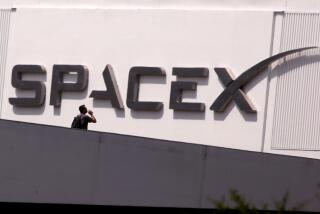Military Dollar Now a Smaller Piece of the Pie : Defense Role in S.D. Economy Shrinks as Other Sectors Grow
Civilian and military observers agree that San Diego County’s economy, which has lived well by the sword of defense spending, would not be seriously wounded if the Bush Administration trimmed the defense budget that hit record heights during the middle years of the Reagan Administration.
To be sure, defense spending will continue to play an important role in the county, which has relied heavily upon the military since 1919, when the San Diego Naval Station opened.
But “defense is slowing down,” according to Max Schetter, research director for the Greater San Diego Chamber of Commerce.
4.9% Decline in Value
The value of manufactured goods in the county fell by 4.9% between 1986 and 1988--with defense firms accounting for most of the decline, Schetter said, adding, “I’d expect to see a continuation of that trend in 1989.”
Defense spending accounted for an estimated 20% of San Diego’s estimated $47.4-billion economy during 1988, he said. The military played a slightly more important role in the county’s economy during 1987, when military contracts and payrolls accounted for 22% of an estimated $42.1-billion economy.
San Diego’s service industries have long done business with the Navy. The county also is home to a panoply of high-tech defense contracting firms that build weaponry systems as well as conduct basic research and development for new systems.
“Defense will continue to be a smaller percentage as other sectors--service, trade, export and manufacturing--grow,” Schetter said. “It’s not going to be like the ‘60s, when nearly all the jobs were in defense.”
“Most of San Diego’s growth in recent years has been in the service sector, not the military,” according to Irving Katz, director of research for Thomas Green/San Diego Securities. “So San Diego is less dependent than it was.”
Some San Diego-based defense contractors have won huge awards in recent months. Science Applications International recently won a $1-billion, eight-year contract to develop a comprehensive health-care record-keeping system for the Pentagon.
11 Atlas Missiles
General Dynamics’ Space Systems Division, the county’s largest defense contracting employer, with 17,000 employees, last year won an Air Force contract to supply 11 Atlas missiles for an estimated $1 billion. GD also won an $82-million developmental contract in connection with the new-generation missile that the Air Force hopes to develop during the next decade.
As defense spending slows, some contractors are marketing their technologies toward economic sectors that are still growing.
Cubic Corp. also used a former defense technology to win a $1-million award to install highway call boxes in Ventura County. Cubic’s Defense Systems subsidiary generated a $14.1-million operating profit and $157.7 million of Cubic’s $364.9 million in total revenue. Cubic reported a $24.1-million net profit during the most recent fiscal year.
Maxwell Laboratories, which is heavily involved in “Star Wars” research-and-development projects, began to expand its non-defense business last year when it became clear that military contracts were getting “more difficult to come by,” according to President Monson Hayes Jr.
That strategy paid off in early December when Maxwell won a $20-million contract to build a light source for a powerful X-ray device that researchers at Louisiana State University believe will have commercial uses for manufacturers of large-scale integrated chips.
“That’s a great contract for a company with $66 million in revenue,” Hayes said.
Highly Secretive Venture
Maxwell also has created “Foodco,”a highly secrete joint venture with a major food company. Maxwell executives decline to talk about the venture that is evidently exploring advances in food processing, but Hayes said the venture “represents a direct application of an existing (military) technology into something that is purely commercial.”
Titan Systems President and Chief Executive Gene W. Ray also acknowledged that there is increased competition among defense contractors for civilian contracts.
“We were one of the companies that Maxwell beat for that Louisiana contract,” Ray said.
Titan, which reported a $335,000 net loss on $22.9 million in revenue for the third quarter ended Sept. 30, is “not scurrying out of defense business,” according to Ray. “That’s our main line of business, and we’ll continue to play to our strengths. But we’ve got a lot of technologies, products and capabilities that are marketable in non-defense areas.”
The Federal Aviation Administration recently awarded Titan a contract to develop some of the sophisticated wind-shear detection technology that could help prevent airliners from crashing during takeoffs and landings.
Titan “is positioned to make a reasonable profit in our defense business this year,” Ray said. “But margins across the industry are down measurably across the board. Every industry executive I talk to says that.”
But some of the county’s defense contractors remain almost totally dependent on defense contracts.
National Steel & Shipbuilding Co., which has reported nearly $30 million in operating losses during the past two years, will continue to rely heavily on Navy contracts, said Nassco spokesman Fred Hallett, one of several Nassco managers who hope to complete a leveraged buyout of the struggling company from Boise, Ida.-based Morrison-Knudsen.
Nassco holds firm contracts to build two fast supply ships for the Navy. But Congress must vote to appropriate funds for two more ships during 1990 and 1991, Hallett said.
More to Read
Inside the business of entertainment
The Wide Shot brings you news, analysis and insights on everything from streaming wars to production — and what it all means for the future.
You may occasionally receive promotional content from the Los Angeles Times.










